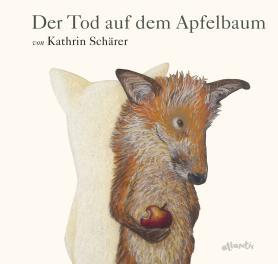Kathrin Schärer
Der Tod auf dem Apfelbaum
[Death on the Apple Tree]
- Atlantis Verlag
- Zurich 2015
- ISBN 978-3715207018
- 36 Pages
- 3 Suitable for age 4 and above
- Publisher’s contact details
Sample translations
The clever eyes of the fox –
Kathrin Schärer’s masterfully illustrated tale about life and death
Despite this, however, the fox is still a smart fellow - you can see it in his eyes: alert and full of vigour, they take in everything that’s happening around him. No wonder, then, that he manages to catch a weasel - a magic weasel, so it turns out, who grants him a wish in exchange for his freedom: anything that climbs up his apple tree or lands on it from the air shall find itself stuck fast. The news soon gets around, and none of the animals dare any longer to go near the tree. Then Death comes calling. Far too soon, thinks the fox. He asks Death to pick him one last apple. Death obligingly climbs up into the tree - and finds himself stuck fast.The fox is safe from him now!
But life carries on in its customary fashion: the fox’s beloved wife dies at some point, even his grandchildren produce children of their own, the fox becomes lame and half-blind, and comes to regard the world as inexplicably strange. Kathrin Schärer tells us her tale by showing us how the body degenerates, how the fox’s eyes lose their sharpness, how his movements are no longer focused and controlled, while his children and grandchildren go about their business with vigour and zest.
All children are fascinated by death, yet at the same time it is beyond their comprehension. Why does something good and beautiful have to disappear? It doesn’t make sense. Kathrin Schärer’s tale is compelling because it sticks firmly to the here and now. We’re not asked here to give Death half-hearted credence on the basis of a succession of reasoned arguments, but neither does Death appear in the guise of a nasty bogeyman. Instead, this Swiss author presents Death as the fox’s double, but a double drawn in washed-out colours, with the result that he comes across as no more nor less appealing than the fox himself. It is rare for us to be offered such a convincing picture of the way death is so much a part of us, something we carry within us from the very beginning.
And so the fox - no longer capable of enjoying the scent of the apple blossom and bereft indeed of everything that had once given him pleasure - comes to yearn for death. He frees Death from the tree, they eat an apple together and hug one another, and by dying he experiences his final, sorrowful pleasure. He lies there now with his eyes closed, just as he was when we first saw him at the beginning side by side with his wife. Right throughout the book our attention is drawn to his eyes, which Kathrin Schärer draws just as vividly as she draws all the rest of the animals’ bodies, the affinity of which to our own human bodies is plain to see.
Despite its difficult topic the book is animated by a generosity of spirit that radiates a constant sense of the joys of life. The double-page spreads provide plenty of space for the airy expanse of branches with their luscious red apples, and the tree as a whole looks as if it were taken straight from a botanical handbook. What gives this book its air of being a potential classic is the careful manner in which its story is developed. Many writers have tried their hand at this theme, but none comes as close as Kathrin Schärer does to matching the masterpiece of the genre - Wolf Erlbruch’s Ente, Tod und Tulpe [Duck, Death and the Tulip].
Schärer’s language in this thoughtfully constructed tale with its wonderfully rounded-off ending gives it a freshness quite different from the mustiness produced by stale platitudes. Without any fuss or palaver her apple tree turns into a Tree of Knowledge heavy with the magnificent fruits of life. What we have here is a work by an artist who has gone from strength to strength in each successive book and with her unmistakable depictions of animals can be counted among the great exponents of the art of illustration.
Translated by John Reddick

By Thomas Linden
Thomas Linden is a journalist (Kölnische Rundschau, WWW.CHOICES.DE) specializing in the areas of literature, theater and film. He also curates exhibitions on photography and picture book illustration.
Publisher's Summary
An elderly fox catches a magic weasel. He lets it go again when it promises him that any creature attempting to steal his apples will stick fast to the tree - for ever and ever. From that moment on he can enjoy his apples undisturbed - until Death comes calling to take him away.
The fox doesn’t want to die yet. He asks Death to pick him one last apple: Death finds himself glued firmly to the tree, and so the fox wins out. But he grows ever older. His wife dies, his children grow old too, and he loses all sense of belonging. Are things going to go on like this for ever?
He finally asks Death to come down from the tree and take him away with him.
Drawing on an ancient fairy-tale motif, Kathrin Schärer demonstrates with a mix of gentleness and puckish verve that death is part of life.
(Text: Atlantis Verlag)
